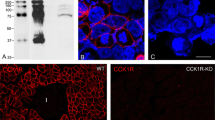Abstract
Antisera to a highly conserved region of chromogranin A (sequence KELTAE) and to a hexapeptide (sequence KGQELE) adjacent to the putative C-terminus of pancreastatin, a peptide whose sequence is found within the chromogranin A molecule, have been used to examine the localisation of immunoreactivity (IR) to these peptides inAscaris suum. IR to both peptides was found in the nerve rings and nerve cords. In addition, KGQELE-IR was also observed in the pharyngeal neurones and in a network of fibres on the surface of the female gonoduct. The staining was specific in that it could be abolished by preincubation of the antisera with the appropriate antigen. The two antisera appeared to be staining different subsets of neurones, suggesting that (at least) two peptides were being recognised. The widespread distribution of IR to both peptides throughout the nervous system of the parasite suggests that the peptides carrying the epitopes recognised by the antisera are of fundamental importance to the functioning of the parasite's nervous system.
Similar content being viewed by others
References
Chitwood BG, Chitwood MB (1950) Introduction to nematology. University Park Press, London
Coons AH, Leduc EH, Connolly JM (1955) Studies on antibody production: I. A method for the histochemical demonstration of specific antibody and its application to a study of the hyperimmune rabbit. J Exp Med 102:49–60
Cowden C, Stretton AOW, Davis RE (1989) AF1, a sequenced bioactive neuropeptide isolated from the nematodeAscaris suum. Neuron 2:1465–1473
Curry WJ, Johnston CF, Hutton JC, Arden SD, Ruherford NG, Shaw C, Buchanan KD (1991) The tissue distribution of rat chromogranin A-derived peptides: evidence for differential tissue processing from sequence specific antisera. Histochemistry 96:531–538
Halton DW, Fairweather I, Shaw C, Johnston CF (1990) Regulatory peptides in parasitic platyhelminths. Parasitol Today 6:284–305
Hutton JC, Nielson E, Kastern W (1988) The molecular cloning of the chromogranin A-like precursor of betagranin and pancreastatin from the endocrine pancreas. FEBS Lett 236:269–274
Iacangelo AL, Fischer-Colbrie R, Koller KJ, Brownstein MJ, Eiden Le (1989) The sequence of porcine chromogranin A messenger RNA demonstrates chromogranin A can serve as a precursor for the biologically active hormone, pancreastatin, Endocrinology 122:2339–2341
Johnston CF, Shaw C, Halton DW, Fairweather I (1990) Confocal scanning laser microscopy and helminth neuroanatomy. Parasitol Today 6:305–308
Maule AG, Shaw C, Halton DW, Thim L, Johnston CF, Fair-weather I, Buchanan KD (1991) Neuropeptide F: a novel parasitic flatworm regulatory peptide fromMoniezia expansa (Cestoda: Cyclophyllidea). Parasitology 102:309–316
McGrath-Linden SJ, Johnston CF, O'Connor DT, Shaw C, Buchanan KD (1991) Pancreatstatin-like immunoreactivity in human carcinoid disease. Regul Peptides 33:55–70
Rieker S, Fischer-Colbrie R, Eiden L, Winkler H (1988) Phylogenetic distribution of peptides related to chromogranins A and B. J Neurochem 50:1066–1073
Sithigorngul P, Stretton AOW, Cowden C (1990) Neuropeptide diversity inAscatis: an immunocytochemical study. J Comp Neurol 294:362–376
Smart D (1989) What are the functions of the catecholamines and 5-hydroxytryptamine in parasitic nematodes? In: Bennet EM, Behm CA, Bryant C (eds) Comparative biochemistry of parasitic helminths. Chapman and Hall, England, pp 25–36
Smart D, Brownlee DJA, Fairweather I, Johnston CF, Halton DW, Shaw C (1990) Lacolisation of regulatory peptides in the nematodeAscaris lumbricoides var.suum. Bull Soc Fr Parasitol 8 [Suppl 1]:113
Stretton AOW, Cowden C, Sithigorgul P, Davis RE (1991) Neuropeptides in the nematodeAscaris suum. Parasitology 102:S107-S116
Sulston JE, DW M, Brenner S (1975) Dopaminergic neurons in the nematodeCaenorhabditis elegans. J Comp Neurol 163:215–226
White SG, Southgate E, Thomson JN, Brenner S (1986) The structure of the nervous system of the nematodeCaenorhabditis elegans. Philos Trans R Soc Lond [Biol] 314:1–340
Author information
Authors and Affiliations
Additional information
The financial support of the Medical Research Council of Great Britain, in the form of a postdoctoral fellowship (awarded to D.S.), is greatly appreciated
Rights and permissions
About this article
Cite this article
Smart, D., Johnston, C.F., Curry, W.J. et al. Immunoreactivity to two specific regions of chromogranin A in the nervous system ofAscaris suum: an immunocytochemical study. Parasitol Res 78, 329–335 (1992). https://doi.org/10.1007/BF00937092
Accepted:
Issue Date:
DOI: https://doi.org/10.1007/BF00937092



